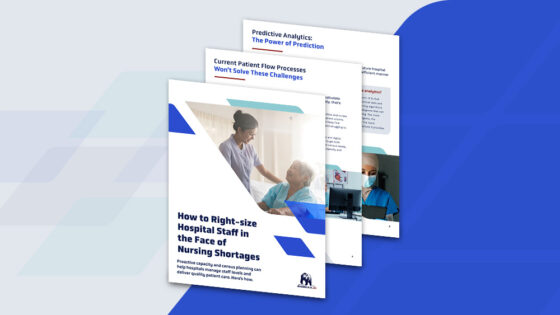How the Right Technology Can Help Reduce Average Length of Stay
Predictive analytics and machine learning technologies can help hospitals gain value-added time and enhance patient care
 Every day a patient stays in the hospital, the costs go up, not just financially but also from a resource perspective. Administrators and nurse leaders end up juggling staff and beds to effectively treat patients. The more they juggle, the more inefficient and expensive patient care becomes, eating into the hospital’s bottom line, further stressing already maxed-out staff, and impacting quality of care.
Every day a patient stays in the hospital, the costs go up, not just financially but also from a resource perspective. Administrators and nurse leaders end up juggling staff and beds to effectively treat patients. The more they juggle, the more inefficient and expensive patient care becomes, eating into the hospital’s bottom line, further stressing already maxed-out staff, and impacting quality of care.
That’s why reducing a patient’s length of stay (LOS) is so important. Even reducing a few hours of time that a patient spends in the hospital can result in thousands of dollars in savings, reduced stress, and the ability to treat patients more effectively. Not to mention opening space for new patients coming in during a surge.
Unfortunately, that’s not happening nearly as much as it should—or can. Instead, too many hospitals are reacting to their current census situations focusing on just today. Without accurate awareness of current and future capacity levels combined, nurse leaders are left to plug holes and reactively shuffle patients between units—even units that don’t apply to patients’ needs—just to have somewhere to place them. Worse yet, during a crisis, patients can end up in the hallway. Meanwhile, the U.S. population continues to grow older, and older patients tend to have longer hospital stays.
Let’s take a closer look at the impact LOS is having on hospitals and explore how predictive analytics and machine learning (ML) technology can help reduce average LOS, allowing hospitals to become more efficient and provide the best standard of care.
The impact of LOS on patient care and hospitals’ bottom lines
Recent reports indicate that the average LOS in the United States is increasing and bringing rising costs along with it:
- A study by the University of San Francisco on patient placement found that LOS “increased from 6 days to 18 days when patients were placed in ‘outlier’ units.”
- The average LOS for people 65 and over is around five days. That’s longer than the 4.5-day average for younger patients.
- The average in-patient room rate is estimated to be $3,199 a day for a senior. The longer the LOS, the more money hospitals end up spending on just that individual.
The growing prevalence of flu, COVID-19, human respiratory syncytial virus (RSV), and other respiratory viruses is further compounding the issue. These viruses tend to attack our most vulnerable populations—the elderly and children. When members of either population are hospitalized, their stays tend to be longer. For aging adults, this could be due to comorbidities or lingering issues. For children, it could simply be that the hospital is overrun and forced to move patients into outlier units to keep up with the inflow.
Using predictive analytics and ML to gain value-added time
For these patients and others, hospitals must reduce the amount of time patients spend in their facilities. That’s because in hospitals, like everywhere else, time is money. There’s value-added time—the time spent efficiently treating patients for maximum effectiveness. But there’s also non-value-added time. That’s the excess time a patient spends hospitalized for no great reason other than the fact that the facility isn’t operating as efficiently as it could be.
Think of an ICU patient who needs to be transferred to a medical-surgical unit. Transferring a patient in the morning rather than the evening is a more efficient use of time and bed space. This alone could shave hours off a single patient’s length of stay. Multiply that by hundreds of patients, and hospitals can realize measurable savings.
Too often, they’re not doing this, for a couple of reasons:
- They do not have visibility into how patients are likely to move throughout their hospital, making it hard to effectively anticipate when a patient should be moved.
- They may not have clear and accurate insights into their current capacity, causing uncertainty as to how many beds are available.
- They are experiencing long discharge wait times, which create huge bottlenecks. In such cases, patients may be well on their way to being discharged, only to end up staying longer because of backups in other departments, lack of resources, and inefficient processes.
Predictive analytics and ML technologies can help. The predictive analytics capabilities of BigBear.ai’s FutureFlowRX, for instance, pull anonymized information directly from past patients’ electronic health records to determine how long certain cohorts of patients are likely to stay in the hospital. That information is fed into an ML algorithm that learns over time and provides accurate insights that help nurse leaders and other practitioners estimate where patients are likely to go while in the hospital, how long they’re likely to stay, and more.
With this information, nurse leaders and hospital administrators can make informed decisions that will help reduce LOS. For example, understanding how long a patient is likely to be in the ICU and where they’re likely to go next can help nurse practitioners plan that patient’s next steps in their hospital journey. They can move patients through their facility more efficiently and focus on providing optimal levels of care while increasing the amount of value-added time spent on each patient and reducing excess costs.
A master plan with reduced LOS
Predictive analytics and ML offer more than just short-term solutions. True, they provide hospital administrators and nurse leaders with the ability to estimate their census and capacity within the next few hours, days, or weeks. But visibility windows can also extend out to months or even years, helping the hospital save significant money over the long term.
Thus, predictive analytics and ML are instrumental for master planning purposes. Hospitals can better plan flexible spaces by accurately gauging how many and what type of beds or units they’ll need to accommodate aging populations, seasonality, spikes in surges, and other factors that could extend LOS. They’ll be prepared for these inevitabilities and attack them proactively. Average LOS will decrease, staff will be less harried, levels of care will improve, and hospitals will find themselves on surer financial footing.
FutureFlow Rx uses a digital twin of your hospital system to model surges and predict patient flow. Learn more about our AI software solutions for hospitals by downloading our white paper: How to Right-size Hospital Staff in the Face of Nursing Shortages.


